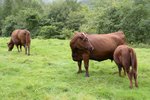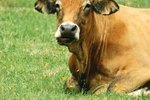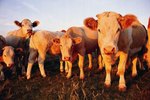What do you get when you cross a Jersey bull with a Holstein cow?
If the offspring is a female, she'd be an F1 heifer, and the results are no joke. The first generation of any crossbred cattle is known as F1, and F1 dairy heifers are likely to produce more milk with less feed than their parents.
Benefits of F1
Advantages of owning an F1 heifer go beyond better feed conversion. With a Jersey-Holstein cross, F1 heifers experience less problems with mastitis, fewer foot issues and required less veterinary care over their lifetime. They also had higher fertility rates and less difficulty calving than purebred Holsteins. F1 heifers have a longer milk-producing life than their parents, which can account for a longer life span when cows are culled after milk production ceases.
F1 Parents
A Jersey or Holstein is a common parent of an F1 heifer. Holsteins' average milk production of 9 gallons per day account for the breed making up 90 percent of dairy cattle in the U.S. The downside of the breed comes with its large size, feed requirements and difficulty in calving. Jersey cows are the second-most popular dairy breed, valued for the high butterfat content of their milk and ability to adapt to extreme temperatures. Besides crossbreeds between the two, you'll find either crossed to other productive breeds such as brown Swiss, Scandinavian red and Montbeliarde cattle.
The Next Generations
When F1 heifers reproduce, their progeny is F2. The F2 heifer's young is an F3 heifer. The designations help the buyer know what breed characteristics to expect as some traits such as milk production can increase over several generations with selective breeding. A 2013 study by the Ethiopian Institute of Agricultural Research suggests that future generations may not live or produce milk as long as their F1 mothers.
Writer Bio
Indulging her passion for vacation vagary through the written word on a full-time basis since 2010, travel funster Jodi Thornton-O'Connell guides readers to the unexpected, quirky, and awe-inspiring.





